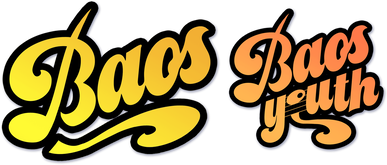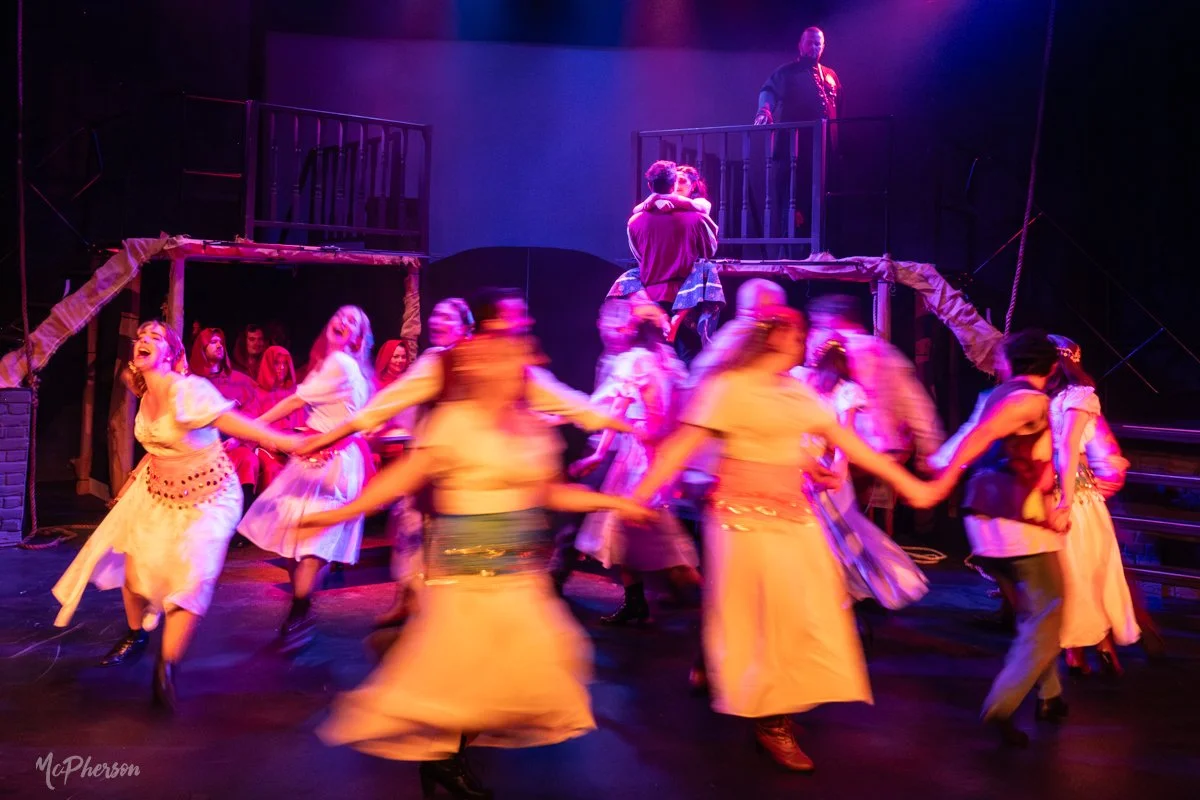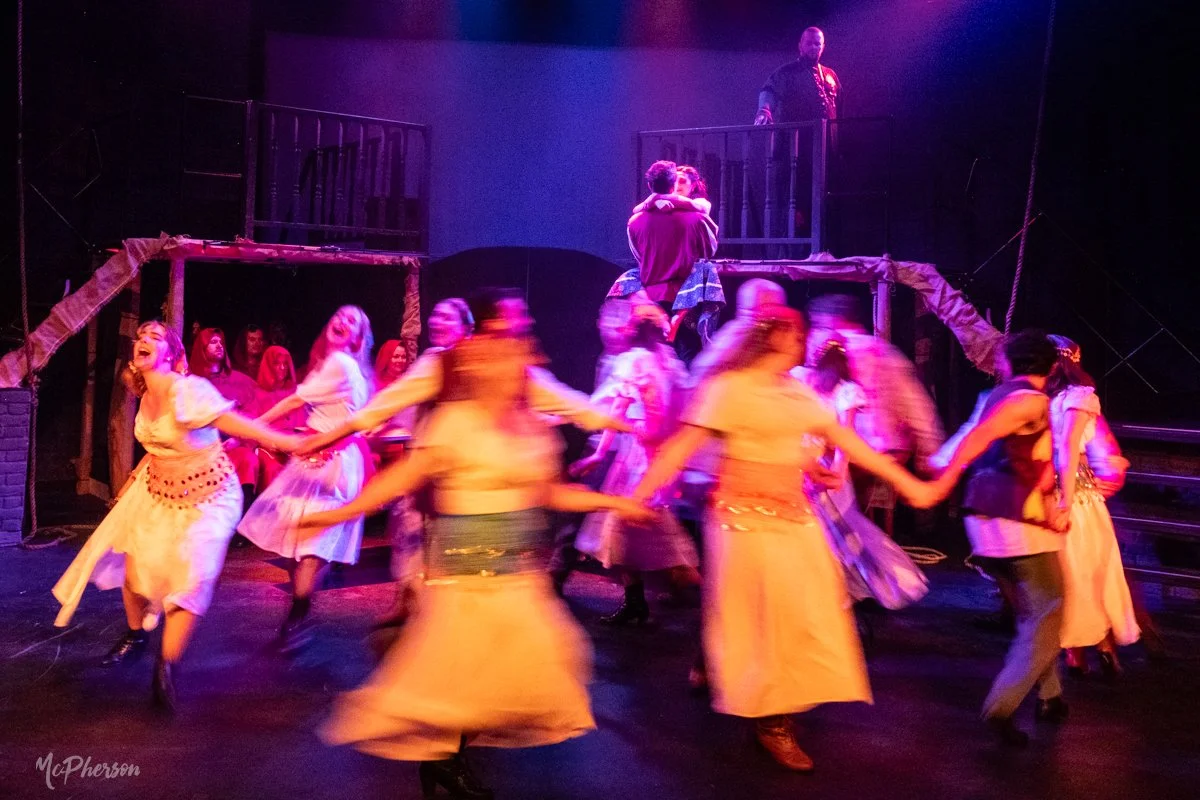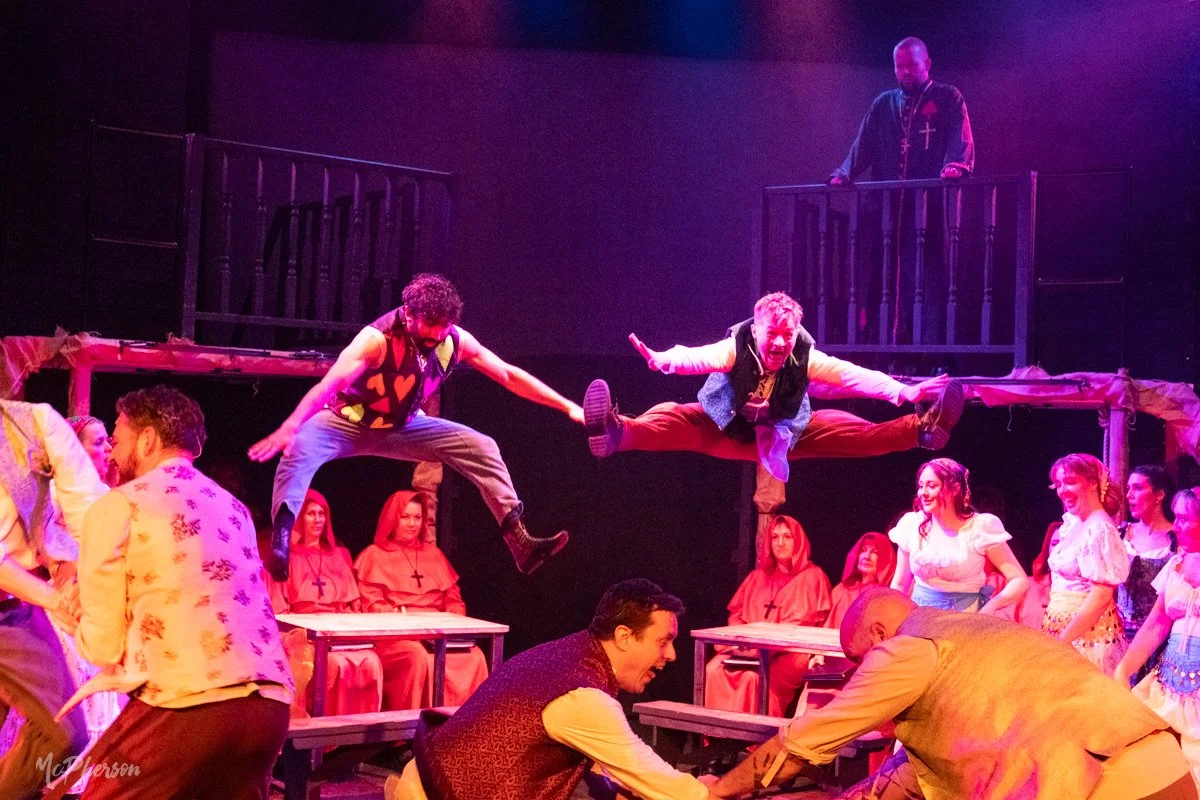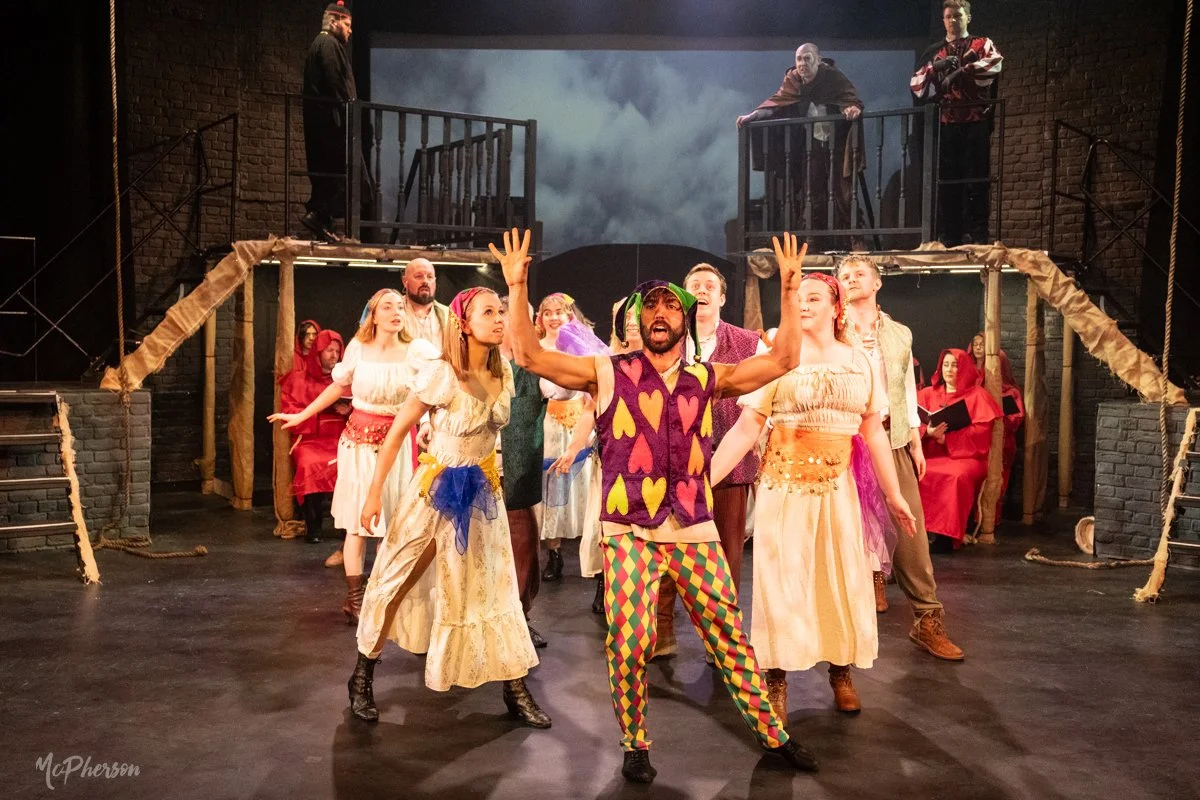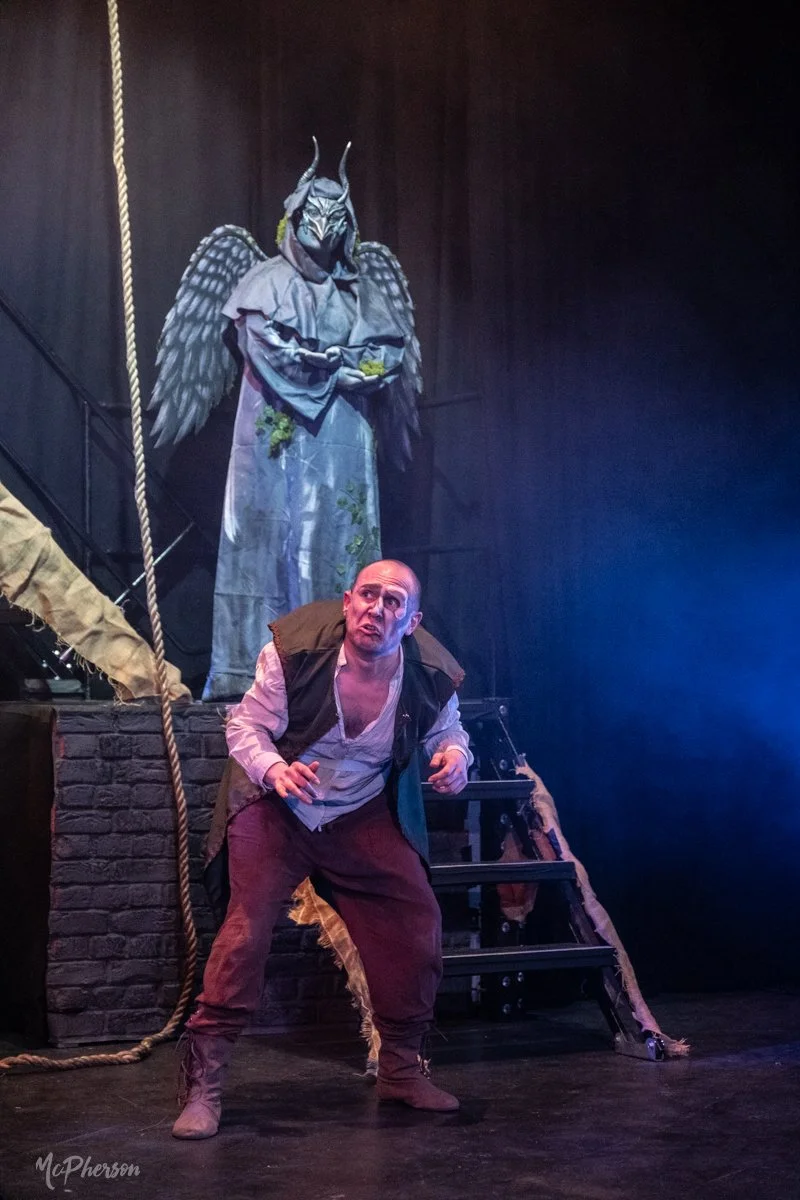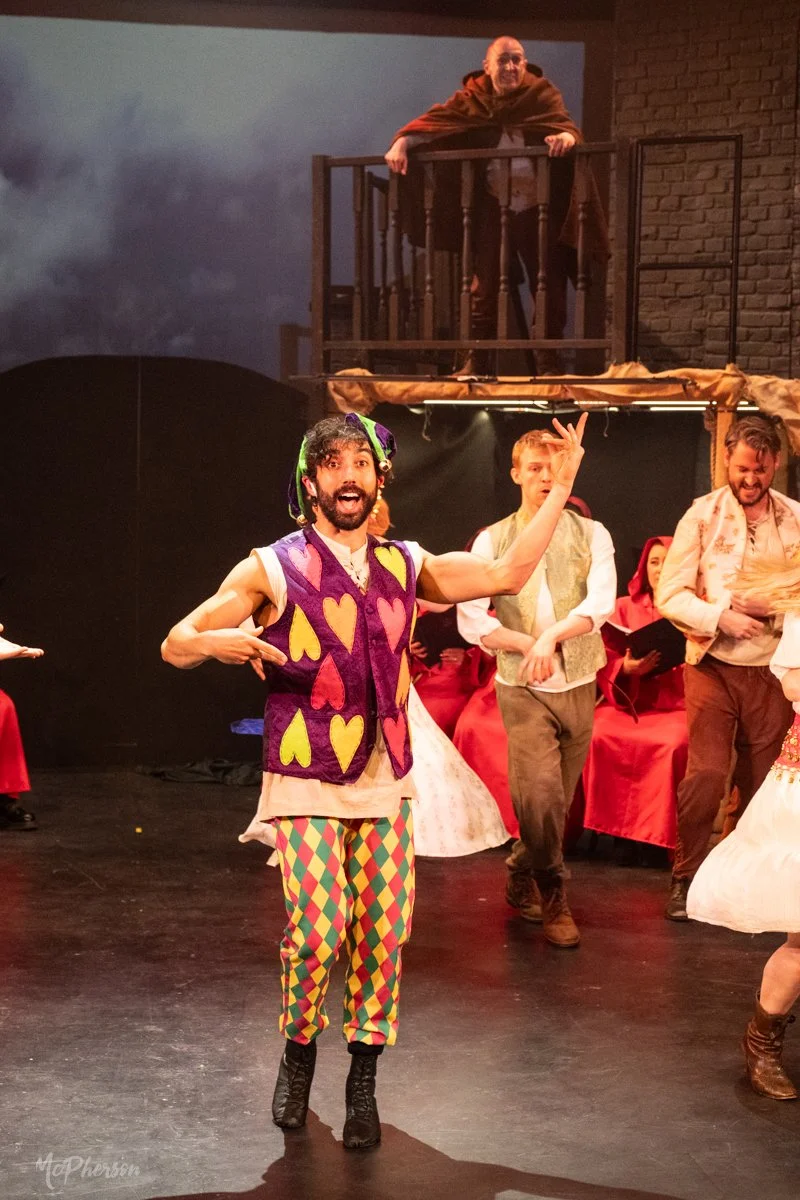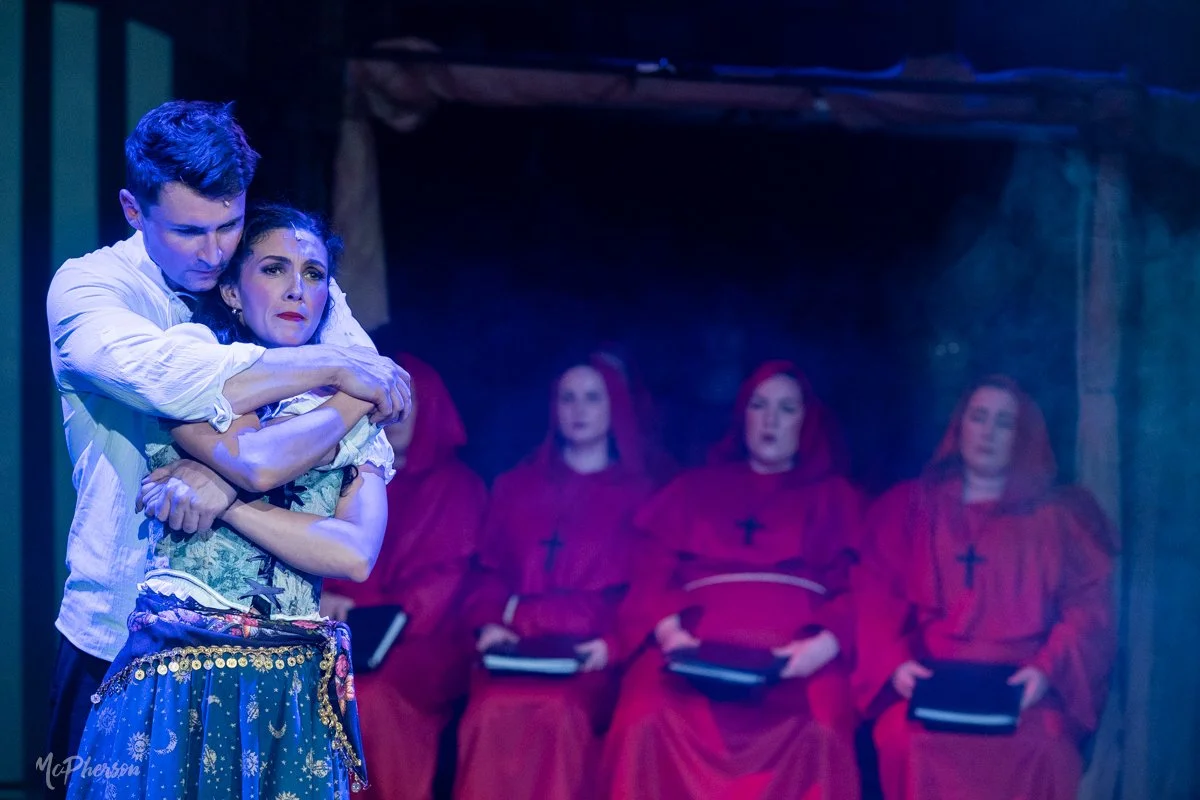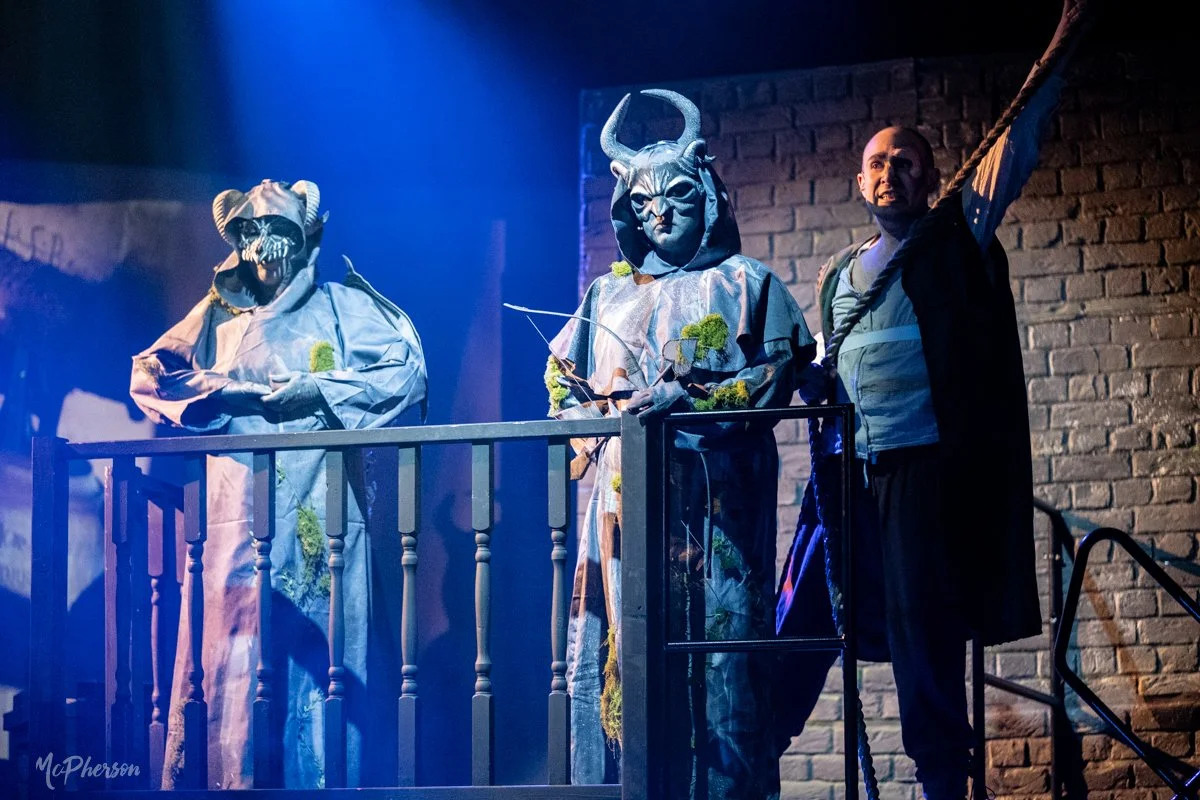
Previous Productions - The Hunchback of Notre Dame
Name of Company: Bristol Amateur Operatic Society
Name of Production: The Hunchback of Notre Dame
Venue: Redgrave Theatre, Percival Road, Bristol Date: 5th April 2025
Adjudicator: Chris Howland-Harris
- AN INTENSE AND EMOTIONAL MELODRAMA
The cast of Bristol Amateur Operatic Society (BAOS) threw themselves wholeheartedly into this long and involved production and came out the other side to a standing ovation from a thrilled and delighted audience.
STAGING AND DIRECTION
The audience was greeted by what appeared at first a simple stage set with two L-shaped stair risers terminating in a balcony platform, one on either side of the stage. This allowed an additional two levels of performance above the stage with cleverly concealed bars that allowed the platform to be accessed directly, something that Director Kris Hallett had the cast make use of to good effect. This design by Chris Thomas, with construction support from Jack Tosney and the ever capable Spirolux, cleverly provided space for the choir to be prominent without obstructing the action, figuratively or literally. It also meant that Kris and Choreographers Mandie Love and Meg Gould could make maximum use of the remaining space, which was necessary as the action
played out by the leads and the performance of the Storytellers made the Redgrave stage seem considerably smaller than usual.
Placed between the two upper platforms was a projection that allowed images of bells and a rose window symbolising the cathedral. No doubt these images are supplied by Disney Theatrical as part of the licencing, but the transitions were performed well as were the sound and lighting overall with just a single minor curse of radio mics in the finale. Overall Kris used lighting of stage and performers very sensibly, giving clear bright and impactful rendering for the main dance numbers of the Storytellers and then dropping the lighting temp and making greater use of colour gels, particularly reds and blues, to enhance feelings of jeopardy and solemnity. I especially appreciated the lighting effect used to project a perception of prison bars upon the stage for a scene with Frollo and Esmarelda, and at this point it sounded as if Kris also used reverb on their mics to enhance this. In fact, this whole scene was directed very well as the prostration of Frollo before Esmarelda felt somehow sordid, justifying the rage and disgust shown by her, followed by an excellent long and uncomfortable pause before a well staged exit and subsequent use of blue gel on Esmarelda to emphasise her sorrow. This effective lighting culminated in the backlit finish to Quasimodo’s Made of Stone song which was the perfect way to finish that number.
Costume design was a credit to Jemma Leese, assisted by Isobel Stack, with clever use of a plain white and cream base for the Storytellers that could be quickly accessorised with wraps and wisps of colour for Gypsy and other scenes. Meanwhile the hooded choir were perfect in their cardinal robes, even the one chorister stage right who appeared to have a slightly oversized hood which meant we never saw much other than his beard. The Gargoyles’ costumes were so good that I initially presumed they were hired in, but I understand that these designed and created in house. They were really impactful and very effective, especially Saint Aphrodisius who was particularly striking as he performed whilst bearing his severed head with his left arm. This was all enhanced by the Gargoyles’ makeup, so well done whoever was responsible for makeup and apologies if I missed their programme credit but I couldn’t find one. I was also particularly pleased that the Gargoyles got to remove their masks for the finale, which was a nice touch.
I understand the need for the choir to have a large printed score, especially for legibility in subdued lighting, but the black plastic ring binders were somewhat
incongruous, as were the metal framed tables brought on with contrastingly appropriate and beautiful wooden benches. The hump being metaphorically worn by Quasimodo is not an uncommon trope but was well done here, and while to have the swaddled child thus transformed was very effective it did
mean the baby noticeably lacked mass. Apart from such minor quibbles, Props were handled well, especially the use of candles from opening walkdown to the flaming torches carried to illuminate the streets.
Brendan Casey had obviously worked at length with the vocal leads. From the opening oratorio The Bells of Notre Dame that set the mark for voices that seemingly resonated and filled the theatre, to the emotional and lilting duet Someday by Esmeralda and Phoebus, the singing overall was extremely proficient. The choir must also have benefited from Brendan’s coaching and direction as their performance was strong and proficient. Understandably the format of the theatre meant that we were unable to see Brendan and his orchestra, but the whole sounded greater than the ten individual players. It’s clear that his musical direction elevated the performance and that the orchestra and cast worked well together under his guidance.
Another aspect that I appreciated was the way in which Kris Hallett had the ensemble on stage hold their pose while other characters sang and performed, the Storytellers particularly demonstrated this as Frollo interacted with his brother in the opening scene.
The joint choreography between Mandie Love and Meg Gould evidently worked well and produced an impressive movement of whole about the confines of the stage. The Storytellers were able to demonstrate great heel-toe rolls even in their built-up boots, while Mandie and Meg had evidently made use of some circus skills within the ensemble that added to the spectacle of Gypsy dancing. This control of movement on stage extended to the scene where Quasimodo is ridiculed and then roped up by the crowd, all of which was performed very smoothly, as was the sense of marching during the song Esmeralda towards the end of Act One through use of rock step. And a nod to James Millward for his well coordinated fight scene.
QUASIMODO
From the moment he literally shouldered his hump, Ryan McKenzie took upon himself the suffering and oppression extremely well, and drew upon
movement that showed to us the weight of sin with which he is burdened by Victor Hugo. This also extended to his stance, wide legged, which lowered his body and added to the persona of Quasimodo. Ryan brought a genuine openness to the role, his simplistic spoken delivery avoiding the prejudicial lisp or drawl, and that followed through into the lovely soft tones of his singing voice with excellent enunciation and a seemingly easy sustain. Most of all Ryan showed us the qualities of Quasimodo – his vulnerability, his loyalties, the conflict between what he felt he owed to Frollo and his platonic love for Esmarelda, and this allowed Kris Hallett to skilfully employ pathos in the scene where Quasimodo is ridiculed by the crowd. Ryan employed great visual interaction with the audience to engage and draw us in, particularly in the song Made of Stone. No wonder by the finale we were moved by his overt and genuine sorrow at the death of Esmarelda, and he ended the performance with an excellent ringing cry of anguish.
FROLLO
Stanford Wildgoose made an immediate impact from his opening sonorous musical voice which resonated beautifully about the stage. His singing was matched by his acting ability as his persona and commanding voice made him a captivating presence whenever on stage, and while his tonal delivery could have allowed a little more freedom of expression, his sense of timing was perfect and maintained an excellent sense of threat leading to a palpable tension in the room. As well as excellent phrasing, Stanford moved with alacrity between lines sung and the recitative. He projected a genuine relationship with Quasimodo, despite being the rock upon which he breaks, and certainly showed the intense inner conflict of this character.
ESMERALDA
From the moment she walked on stage Catt Hurman moved with a powerfully lythe and sinuous gait that bespoke an archetypal Gypsy character. She spoke to the audience with very expressive eyes and moved with a suppleness and balance that meant we were not surprised by how easily she lowered into a floor split. Catt’s physical ability was matched by great emotion and strength in her singing voice which sounded perfectly pitched, and her acting which
showed shades of feeling but also a power which alluded to a feistiness required by her character.
PHOEBUS
The role of clean cut hero fell to Dominic Callaghan who entered with just the right amount of nuanced swagger to avoid the pantomime Flashheart. Amongst the frenzy of movement, colour and song Dominic was something stolid, his stillness gave an appropriate sense of gallantry, and this was enhanced on the occasions when his delivery was slower and more measured. Indeed, Phoebus was at his most expressive when singing as Dominic seemed more relaxed to sing his lines and particularly when engaging with Esmarelda as demonstrated in the song In a Place of Miracles which was the show stopping number for me.
CLOPIN
Samuel J. Mitchell was hugely charismatic as Clopin, and would have stood out even without the extravagantly colourful costume afforded him by Jemma Leese. Samuel presented a Gypsy King who truly held court and blended the role with that of Master of Ceremonies. He has a very expressive face, and combined a real acting skill with a lightness and suppleness that allowed us to genuinely believe he could disappear in a puff of smoke.
GARGOYLES
It’s not an easy task to perform in heavy and cumbersome costumes with almost full face masks, so fortunately the Gargoyles as creatures of stone were not intended to have a lot of movement. Despite this they were able to impart a relationship with Quasimodo through their gestures and the inclinations of their figures. Their speech and song was clear through the head mics, and I’m glad that Kris chose to give them the light voices that you might imagine in Quasimodo’s mind rather than something deeper or monstrous. When given a more layered song the Gargoyles demonstrated good harmonies and kept time well with each other.
STOREYTELLERS
There was no doubt that the Storytellers had the most work to do, the most energy to expend, and made some of the greatest visual and vocal impact. Whenever they were on stage there was action and spectacle, and they fulfilled their title by driving the story on. The Directors and Choreographers must have spent a lot of time coaching and guiding the Storytellers because their movements about stage and their vocal performances were both clear and precise.
CHOIR
The choir were a real foundation to this production, being a constant presence on stage throughout the performance and supporting two thirds of the songs. From their opening this 17 strong cowled monastic chorus produced a beautifully rounded sound, and it was very pleasing that they get their place in the limelight for Entr'acte at the opening of Act Two.
CONCLUSION
This musical is a challenge for even professional companies, so it was bold for BAOS to tackle this expansive tale that needed passion and depth for a story told by cast, choir, and orchestra coming together. BOAS showed fortune favours the bold, and the closing night standing ovation from young and old in the audience attested to the skill, effort, and sheer enthusiasm of all involved.
CHH
BAOS: THE HUNCHBACK OF NOTRE DAME
As seen by Matthew Heaton at The Redgrave Theatre 4th April 2025 for Debi Weaver NODA SW District 13 Representative
DIRECTOR: Kris Hallet
MUSICAL DIRECTOR: Brendan Casey
CHOREOGRAPHER: Mandie Love and Meg Gould
ASSISTANT MUSICAL DIRECTOR: Naomi Lane
I have seen and enjoyed BAOS productions many times in the part, but this is my first time completing a report. I did move from the allocates two seats in Row ‘A’ as I feared sitting that close to you with a notepad out would not be helpful to the cast! The show’s vocal numbers were not detailed in the programme, so I’ve used my best deductions to identify each one, so apologies for any errors.
To start with some context of the show, The Hunchback of Notre Dame is a musical with music by Alan Menken and lyrics by Stephen Schwartz. It is adapted from Walt Disney Animation Studios' 1996 film, which in turn was based on the 1831 novel by Victor Hugo. The musical premiered in 1999 in Berlin as Der Glöckner von Notre Dame, produced by Disney Theatrical Productions and being the company's first musical to premiere outside the United States. It ran for three years, becoming one of Berlin's longest-running musicals. The English-language version, with a revised book by Peter Parnell, then ran in the US but curiously never on Broadway. The musical is notably darker and thematically closer to the source material than the animated film, with Menkin and Schwartz repurposing and rewriting several songs to match the original tone of the Hugo novel. This included some original characters from the novel well as the new songs to extend the musical spectrum including Roma style. In trying to understand the underlying themes of the show - the original production teams commented that the show describes “how to behave when in contact with others different from ourselves” as well as being about "…Characters all coming together, all with purpose, all trying to do the right thing facing extraordinary obstacles... We don't offer a solution, but we go to this place that you or others may call dark, that I would call life."
I don’t usually start with the music in a report – but with this show I really must. Musically, the show was quite incredible overall. The quality of the vocal performances from the principals and the chorus in particular was absolutely outstanding and so great to hear. The dedicated Choir was the main driver for this, dressed with red robes to match the period, singing from books. Not all groups use a dedicated choir for this production, though I understand Menken and Schwartz felt that having a live choir on stage was integral in achieving the full-bodied sound they had crafted – and your decision to follow this ambition really paid off. The music rests upon a series of musical leitmotifs, which are reprised either instrumentally or vocally. The Bells of Notre Dame acts as a narrative device to tell parts of the story, which you used to excellent effect. As well as this, particular vocal highlights to me were Esmerelda, as the Finale of Act 1 and the extensive Finale of Act 2. The Entr’acte at the start of Act 2 seemed fiendishly difficult was extremely well-sung overall, keeping focussed even with a few challenging moments. Staging the Choir underneath the two first stage levels supported this greatly. Vocal support from the Story-Tellers was excellent too. The Orchestra were well-controlled and accurate and well-integrated with the vocals. Overall, this was a significant achievement from everyone involved – very well done!
The choreography was well put-together. Having the Choir also enabled the movement and choreography to be undertaken further by the younger and more energetic members of the Society. This dance experience allowed more complex routines, both as individuals and as pairings. Of particular note were Topsy Turvy, Rhythm of the Tambourine and the Tavern Song, though all of the choreography was most impressive. The sword fight too was well-staged. Quasimodo’s ‘carried’ jump from the rope to save Esmerelda was very inventive and worked brilliantly. Great work overall here.
The fixed-set design was very impressive on entry to the auditorium. You were able to gain the height needed, particularly for a church bell-tower with symmetrical double-level platforms, allowing access from the front, back and two well-used side-mounted ladders. Between these were some quite excellent and well-used giant gates, which brought the whole structure together. The platforms were well utilized, including the seating of the choir beneath them. To change the appearance of the location with such a fixed set, projections were frequently used to good effect to help explain the change of scene – with the stained-glass window, the moving bells and the fire the most effective. This height did give some safety staging challenges with Quasimodo’s throw of Frollo off the bell tower at the end of Act 2. However, this is all the more impressive after I discovered a few days later just how little time you had to set this up with your production issues – very well done to the team who sorted all of this out in such a short period of time and for the cast and crew in working with it so successfully.
The lighting and visual effects were very well-constructed. There was a good use of colour - the reds and purples worked particularly well for me in creating atmosphere. Haze was well-used too, to support the lighting effects and it provided to be a suitably eerie effect. A good use of gobos and other projection was made creating a lot of great effects on the stage floor. The prison bars effect worked expertly and created a most dramatic effect. Some of the more intimate scenes and songs I felt could even have been lit a little less widely – just focussing on the key characters involved perhaps, which would have helped to drive a little more emotion into the action. That said, both Top of the World and In a Place of Miracles. were particularly well-set, combining the staging and lighting expertly.
As well as projection as we have mentioned to add to the atmosphere, the smoke ‘disappearance’ effect for Esmerelda and Clopin worked brilliantly. You probably needed something as dramatic as this for Quasimodos’s throw of Frollo and the thrown objects / molten lead on the people below to maintain the drama, which may have been just projection to support the action and heighten the tension. However, this may have been affected by your staging challenges. Properties flicked between physical props and those of the imagination, which I suspect was for a similar reason. Where used, they were very effective – the rope capture of Quasimodo and their reuse for the hanging effect in Act 2 was a real highlight.
Sound was excellent, in terms of balance between the orchestra and the performers and the principals and the chorus and choir. This was no easy task with the huge number of people and microphones involved here. Cueing went really well too, particularly with all the Story-Tellers with individual lines in various numbers. Sound effects where used were effective and on-time. Impressive work overall.
The costumes were well-thought out and very effective. The red cloaks already mentioned for the Choir were well-suited to the period and worked well with the range of cast. The costumes for the townspeople / gypsies as the story-tellers were of the period, bright and worked well with the movement and dance they were used within. The soldier costumes were effective too and Captain Phoebus looked suitably dashing. The principals were well-costumed overall - Clopin and Esmerelda were in appropriate attire and there were some impressive robes used for Frollo. The Gargoyles were spectacular and suitably grotesque, contrasting to their characters. I feel I know what you were intending and symbolising with Quasimodo’s ‘hump’, though I’m not sure it completely worked with the choice of materials. Hair and Make-up was very good and appropriate for the period. Some really nice work was done on the make-up for the Gargoyles, and I think you pitched the make-up at the right level for Quasimodo. Overall, some lovely work here.
I think this is a really difficult show to direct – it’s a serious and emotional piece and there isn’t a lot of humour as a contrast or as an audience may expected. A really good use of the space was made and with a variety of entries and exits, including entering through the audience which worked really well for a lovely opening scene in particular. The issues you faced with your set probably affected some of your planned movements, as occasionally some of the story-telling and characterisations were a little flat, maybe as positionings were not always where and when I imagine you intended them. However, this didn’t affect the overall enjoyment of the production.
In terms of the principal performances:
Quasimodo (Ryan McKenzie). This was a tremendous vocal performance. Out There in Act 1 is the role’s signature piece which was performed exceptionally well. Made of Stone in Act 2 was a real highlight also. It is difficult to decide how to play a character apparently deaf from bell-ringing and with other deformities, but I though you pitched this all within the part really well, ensuring the role could still be articulated sufficiently. As required, you completely had the audience’s sympathies and engagement in your portrayal. Great work.
Frollo (Stanford Wildgoose). What an incredible voice you have and so appropriate for this role. Hellfire is this character’s central theme and you gave a terrific vocal performance here. You played the part of Frollo very straight, which gave an incredible level of gravitas at the start, though I felt it needed a little more emotion in the dialogue once spurned by Esmerelda and as he falls apart when losing control of all he knew. Overall, a very impressive performance.
Esmerelda (Catt Hurman). Rhythm of the Tambourine was effectively your opening scene and your impressive singing voice and dancing ability shone. God Help the Outcasts and Top of the World were real show highlights that you played a big part in. I’d have liked more made of your interactions with Phoebus, though your death was a moving part of the show and quite unexpected to many and was the emotional peak of the performance. Well done.
Phoebus (Dominic Callaghan) You were every part the dashing soldier and played the part well. You sang your signature number Rest and Recreation most impressively. I felt some of the dialogue needed a little more passion with Esmerelda, though Someday was a really lovely duet. Nice work.
Clopin (Samuel.J.Mitchell), You built a really nice character and acted, sang and danced the part really well, with Topsy Turvy Part 1 and The Court of Miracles being especially well done.
The Story-Tellers performed impressively too - you were indeed blessed with some great performers in terms of singing and dancing ability. All had vocal lines and narration to add, which they did with accuracy and purpose. As a point, an audience cannot stop looking for someone when they are singing a line in a group and sometimes this was difficult to determine with the Story-Tellers - just a little more of a gesture or a positioning step here would probably have sufficed. The Gargoyles are not the comic relief from the 1996 movie, but serve as figments of Quasimodo’s imagination, providing insight into his thoughts and attitudes, effectively acting as a Greek chorus. The parts were well-sung (Flight into Egypt and Made of Stone for example) and supported the story well. Your collective movements were well-controlled and very effective.
In summary, this was another very strong performance from BAOS, with some quite exceptional principal and chorus singing and movement. Sound and lighting were impressive highlights, but your set and how you overcame your staging and performance issues with it were little short of miraculous! Congratulations to you all. Thank you for your hospitality and a very entertaining evening out.
PLEASE NOTE:
Any observation made by the reviewer can only be based on what he sees at the performance in question. The reviewer may have received information in advance of the performance and it is inevitable that his assessment will be effected by that knowledge.
The N.O.D.A. Representative’s intention is to give an objective critique of the overall production and in particular the performance viewed. It should be remembered that any review of this nature can only be objective as far as the techniques used during the performance observed. Any criticisms expressed may not have been valid at other performances, and are only made to encourage higher standards in Amateur Theatre.
It is hoped that the audience’s appreciation of your efforts will have given everyone a lift and encouraged you to greater achievements in the future and that the observations made by the reviewer will prove helpful in improving future productions.
